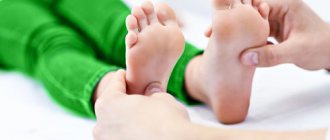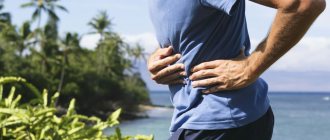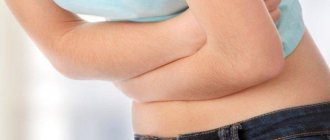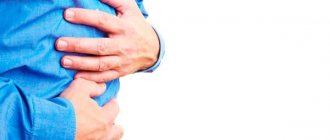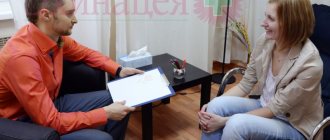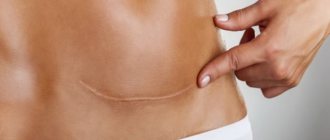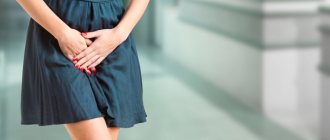Cramping pain in the abdomen
CRACING ABDOMINAL PAIN is an unpleasant, sharp, sudden painful sensation in various parts of the abdomen, which can be associated with a large number of diseases, not only of the gastrointestinal tract, but also of other organ systems.
Most often, this condition is associated with spasms in the biliary system, stomach, and intestines.
“Symptoms of anxiety”: if the cramping pain in the abdomen is of high intensity, accompanied by fever, chills, nausea, vomiting, severe bloating in the abdomen, constipation or diarrhea, the appearance of blood in the stool, tension in the anterior abdominal wall, sharp pain when lightly touching the stomach or bed shaking - you should immediately consult a doctor, as an examination of the abdomen, blood tests, ultrasound examination of the abdominal cavity and possibly other studies are necessary to exclude acute surgical and other serious pathologies.
Causes of cramping pain in the right half of the abdomen:
- acute appendicitis
- diseases of the stomach and duodenum (acute erosive gastroduodenitis, peptic ulcer, stomach cancer)
- diseases of the liver and biliary system (acute cholecystitis, cholelithiasis and biliary colic, biliary dyskinesia with spasm of the gallbladder and bile duct sphincters, abscess, liver cancer)
- intestinal diseases (acute infectious enterocolitis, intestinal obstruction, strangulated hernia of the anterior abdominal wall, Crohn's disease, ulcerative colitis, diverticulitis, intestinal cancer)
- damage to the vessels of the abdominal cavity (dissecting aortic aneurysm, thrombosis and embolism of intestinal vessels, hepatic veins, portal vein, thrombosis of the right renal artery)
- diseases of the urinary system (urolithiasis and renal colic, cancer of the right kidney)
- diseases of the genital organs (acute right-sided adnexitis, ovarian cyst, ectopic pregnancy, dysmenorrhea, acute prostatitis)
- diseases of the nervous system (shingles (herpes zoster), damage to the solar plexus)
- diseases of the chest organs (lower lobe right-sided pneumonia, pleurisy, pneumothorax, acute myocardial infarction, pulmonary embolism)
- diseases of the endocrine system (diabetic ketoacidosis)
- rare diseases (acute intermittent porphyria, lead colic, periodic illness)
Causes of cramping pain in the left half of the abdomen:
- pancreatic diseases (acute pancreatitis, cancer)
- stomach diseases (acute erosive gastritis, peptic ulcer, stomach cancer)
- intestinal diseases (acute infectious enterocolitis, intestinal obstruction, strangulated hernia of the anterior abdominal wall, Crohn's disease, ulcerative colitis, diverticulitis, intestinal cancer, Makelia-Dvorkin-Biehl syndrome (splenic flexure syndrome of the colon with severe accumulation of gases)
- diseases of the spleen (splenomegaly in blood diseases, infectious diseases, cirrhosis of the liver; cysts, tumors, abscess, rupture, perisplenitis, impaired blood supply - splenic infarction)
- damage to the vessels of the abdominal cavity (dissecting aortic aneurysm, thrombosis and embolism of intestinal vessels, thrombosis of the splenic vein, left renal artery)
- diseases of the urinary system (urolithiasis and renal colic, cancer of the left kidney)
- diseases of the genital organs (acute left-sided adnexitis, ovarian cyst, ectopic pregnancy, dysmenorrhea, acute prostatitis)
- diseases of the nervous system (shingles (herpes zoster), damage to the solar plexus)
Causes of cramping pain in the epigastrium:
- acute appendicitis (at the onset of the disease)
- stomach diseases (acute gastritis, stomach ulcers, cancer)
- hiatal hernia (strangulation)
- pancreatic diseases (acute pancreatitis, cysts, cancer)
- diseases of the biliary system (acute cholecystitis, cholelithiasis and biliary colic, biliary dyskinesia with spasm of the gallbladder)
- bowel disease (irritable bowel syndrome)
- damage to the vessels of the abdominal cavity (dissecting aortic aneurysm, thrombosis and embolism)
- diseases of the nervous system (shingles (herpes zoster), damage to the solar plexus)
- heart disease (acute myocardial infarction)
At our center, we are engaged in determining the cause of cramping abdominal pain, conducting examinations and differential diagnosis of this condition. Experienced medical specialists (gastroenterologist, surgeon, neurologist, endocrinologist, psychotherapist), as well as the opportunity to be examined using expert-class equipment (ultrasound, videogastroduodenoscopy, colonoscopy) will help you deal with this problem.
Cramping pain in the abdomen
Natalia
February 19, 2020
Good day, dear doctors!
I turn to you for objective comments! I will try to explain everything in detail. 6 days ago I began to experience attacks of pain in the abdomen, in the intestinal area. It is difficult to give an exact area of painful sensations: sometimes it radiates to the right side, sometimes it surrounds, sometimes just in the middle of the abdomen. The pain begins suddenly, gradually intensifies into a very sharp, severe pain that lasts 5-7 seconds, then gradually releases and subsides, and so on every 15-25 minutes. It happens more often when changing body position and simply at rest. No fever, no nausea, sometimes freezing from pain. The pain also appears at night, and as the morning approaches, the frequency decreases slightly. And then everything is stable again. The day before, a couple of days before the onset of the attacks, there were errors in nutrition, I ate fatty meat, pizza, sweets and wine. But after the feast, she took action and switched to proper nutrition. When the attacks started, I mistook them for irritable bowel syndrome. Since even during the pain my stomach was seething, I had the urge to go big. There was no diarrhea or constipation. I went to the toilet normally. I switched to a gentle diet from that day to this day, taking 1 tablet of Omez in the morning, with Hilak-Forte during meals. Nothing helped, the attacks were stable. On the 5th day, I went to see a general practitioner and donated urine and blood. I am attaching the results. No protein was detected in the urine, the analysis was normal. Blood RBC slightly elevated 4.76; HGB lowered 101; HCT decreased 34.7; MCV down 72.9; MCH 21.2; MCHC 291; RDV-CV is higher than 19.5, leukocytes are normal. I was examined by a surgeon and had an ultrasound of the abdominal cavity. ULTRASOUND RESULT: Liver is normal, gall bladder, pancreas, spleen are normal. IN THE RIGHT LATERAL AREA WITH TRANSITION TO THE SUBHEPATIC INFILTRATE 73x52mm with heterogeneous contents. IN THE RIGHT ILLIAC REGION AND IN THE PELVIC CAVITY INTERLOOP, BEHIND THE UTERUS, THERE IS A SMALL QUANTITY OF LIQUID. CONCLUSION - ULTRASOUND SIGNS: INFILTRATE OF THE ABDOMINAL CAVITY, FLUID IN THE PELVIC CAVITY AND IN THE ILLIAC REGION ON THE RIGHT. I was examined by a gynecologist. Because An ultrasound of the abdominal cavity showed the presence of fluid in the pelvis and behind the uterus; I was punctured with three punctures, because... It was not possible to take this liquid for analysis; as a result, there were empty punctures, i.e. No liquid. The gynecologist made a preliminary decision to hospitalize me in the gynecology department for observation. (For information: I was examined by a gynecologist 3 months ago, smears and ultrasounds were all fine. I have not had any sexual activity in the last few months, pregnancy and ectopic are excluded, as well as sexually transmitted infections). Before being admitted to the gynecology department, the surgeon examined me again, palpated my abdomen, assured me that it didn’t look like appendicitis, and sent me to the gynecology department. I am in gynecology for the 2nd day: they prescribed treatment: Ceftriaxone IM 2 times a day, Metoanidazole tablet 2 times a day, Drotaverine and Etamzilat IM 1 time a day. Plus I took Linex. After 2 days the attacks went away, I felt much better! I did a second ultrasound and the infiltrate became smaller, but the doctor advised me to do an MRI with contrast. I did it, I attach the result. The MRI doctor asked for a long time about my symptoms and said that there seemed to be traces of blood in the bile. In conclusion, she wrote that hemorrhagic cholecystitis (attached photo). At the time of the mri and for several days after, I felt like a healthy person, I ate normally, without dieting. I went to see my therapist, and based on the MRI report, he prescribed Duspatalin, diet 5 and eating more fiber. I included apples and cucumbers in the menu. In general, I ate everything. Three days ago I again started having cramping sharp pains in my stomach, pain in different places, sometimes near the navel, sometimes a little higher, lower to the right and left, sometimes a pain in the stomach, more often pain to the right. The pain-contraction is increasing, VERY PAINFUL, the stomach is spasmodic and hard at this moment. Then he lets go and relaxes. In addition, my back still hurts, sometimes it aches, but then it goes away. The stool is regular, formed, happens 3-4 times a day. It's easier after you have a bowel movement. Sometimes, while lying down, there is a sharp contraction to the right of the navel, you can see in the stomach how it tenses and rises, then the gases pass (a little and infrequently) and she relaxes. I turned to a Gastroenterologist, after feeling my stomach and listening to the symptoms, she suggested that it could be an ulcer. She sent me for further examination: a stool test for coprogram and occult blood, as well as an FGDS with a biopsy for Helicobacterium. For the period of examination, she prescribed treatment - strict diet 1, Rabeprazole 1 time per day, Trimedat 3 times before meals and Almagel 3 times per day. Today is the first day on this treatment and diet. The results are still unknown, at the FGDS tomorrow. The symptoms are still the same, the pain still appears with contractions after eating, I drank Almagel at night, my stomach calmed down at night. I am very afraid of complications from an incorrect diagnosis, I sleep with a bag, just in case I have to call an ambulance. Tell me, based on the picture I described, could there be undiagnosed appendicitis, peritonitis, etc. And comment on your opinion, what are the symptoms like? I just received the result of a stool test and attached a photo. Chronic diseases:
Previous oncology (colorectal cancer)
The question is closed
Cramping pain in the abdomen
Treatment of stomach pain
Gastralgia is cramping pain in the stomach that occurs as a result of diseases of the stomach itself, as well as with autonomic neuroses and some other diseases. Stomach pain is usually felt in the 4th left intercostal space.
Symptoms of pain in the stomach
The intensity of pain in stomach diseases can vary.
In patients with chronic gastritis, pain in the stomach area is not very intense. Therefore, the patient does not pay attention to it for a long time. Low-intensity pain can occur with gastric ulcers and stomach cancer. However, with a gastric ulcer, and especially with a duodenal ulcer, the pain can be severe, sometimes very strong, forcing the patient to immediately take measures to alleviate the condition. With a perforated ulcer, the pain intensity is so high that the patient may develop pain shock. In patients with duodenitis, the intensity of pain can also be very significant.
It is difficult to judge the nature of the disease by the intensity of pain, since this characteristic of pain is largely determined by the individual, personal perception of it. It has been noted that in patients who have undergone surgery on the stomach, the intensity of pain, even with an exacerbation of peptic ulcer disease, may be low. In these patients, during an exacerbation of peptic ulcer disease, there may be no pain at all.
Nature of pain
The nature of pain in stomach diseases may indicate not only a particular disease, but also the presence of complications. Thus, the appearance of persistent burning pain in patients with gastritis or peptic ulcer may indicate the addition of solarium.
Patients with chronic gastritis with reduced secretory function usually experience heaviness and a feeling of fullness in the epigastrium. A feeling of fullness in the epigastrium also appears with pyloric stenosis. The cause of intense pain in these patients is likely to be the addition of cholecystitis, pancreatitis, or colitis. In patients with chronic gastritis with preserved secretion, the pain is often dull and aching.
With a gastric ulcer, the nature of the pain is usually the same, but it can also be cramping and sharp. Intense cutting, stabbing, cramping, sucking pain is characteristic of duodenal ulcer and exacerbation of chronic duodenitis. “Dagger” pain occurs when the ulcer perforates.
Causes of pain
This characteristic of pain syndrome has very important diagnostic significance. First of all, it is necessary to pay attention to the connection between pain and food intake and the nature of the food taken. With chronic gastritis, there is usually an early onset of pain: almost immediately after eating, especially if the food is coarse and sour. With a stomach ulcer, pain also occurs after eating, but no later than 1-1.5 hours after eating. With a pyloric canal ulcer, pain appears 1-1.5 hours after eating.
When an ulcer is localized in the duodenum, late pain usually occurs - later than 1.5-2 hours after eating. However, this characteristic is closely related to the quality of food taken. Foods with a high alkaline buffer capacity (boiled meat, dairy products, except fermented milk) cause pain to appear later. Rough plant foods, vegetable marinades, brown bread, and canned food cause pain to appear earlier.
The so-called early pain can cause the patient to fear before eating. Patients begin to refuse food. A different picture is observed in patients suffering from duodenitis and duodenal ulcer. Their pain is “hungry”, nocturnal in nature and is relieved by taking liquid (milk) or soft (porridge, mashed potatoes, minced meat or fish) food, and drinking soda.
The patient may associate the appearance of pain with physical activity or neuropsychic overload. Patients with duodenitis and peptic ulcers sometimes associate the appearance of pain with these reasons, and not with food intake. Patients suffering from stomach cancer often cannot associate the occurrence of pain with any specific causes.
